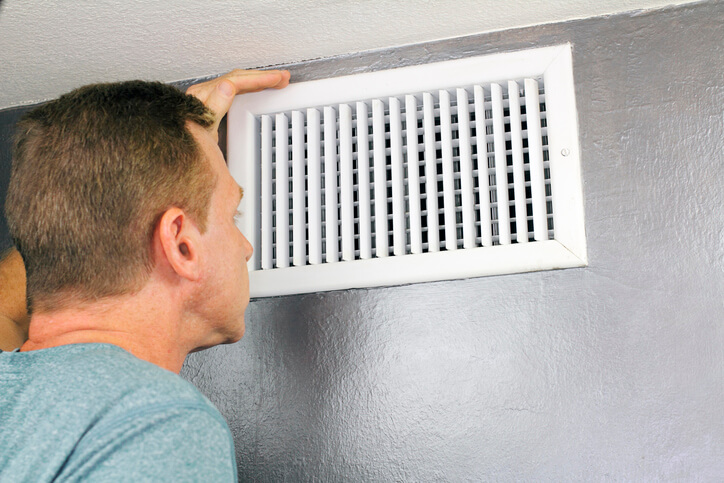
The Dangers Of Mold In Your AC
You already know mold growing on leftovers in the fridge means not to reheat them, but what about mold in your AC? It’s more than unsightly — it’s dangerous, as short- and long-term exposure to the spores can trigger and/or exacerbate health issues for people of any age.
The HVAC experts at LIBERTYAIR Air Conditioning & Heating are here to explain to you these dangers, as well as provide you with fast and effective ac repairs for mold issues and more. Contact us today to schedule HVAC services!
Can Mold Grow In An Air Conditioner?
Yes. An air conditioner is an ideal environment for mold to grow as it has both ample amounts of heat and moisture. This is amplified by the fact that an air conditioner may run intermittently, even during the summer. Without a consistent airflow, things like dust, dirt, and other organic particles can build up inside the unit and adjacent ductwork — all of which can help mold grow.
Even worse, the microscopic spores produced by mold can then be distributed throughout the house via the ductwork and air vents, significantly reducing your indoor air quality and further impacting your health.
What Does Mold Look Like?
Regular AC maintenance is the best way to find molding before it becomes an issue. However, sometimes, mold can develop between maintenance appointments. Mold has a wide range of colorations and textures, usually dependant on the specific type. The most common sign of mold growth is its trademark musty smell and a black, or dark-colored, patchy residue that is difficult to completely clean away.
How Can Mold In My AC Affect My Health?
There are numerous safety hazards related to mold. Short- and long-term mold exposure can have a variety of effects on people and pets, but constant exposure is generally more severe for children, the elderly, and people with health issues.
If you suspect or find mold in the air conditioner, contact our mold testing professionals immediately. They can use conventional mold testing methods to determine which and how many of the 12 main types of mold are present within your HVAC system. Molding can be classified into three main categories:
- Allergenic: This category of mold can cause reactions and symptoms related to allergies.
- Pathogenic: These molds exacerbate symptoms related to an acute illness, such as a viral infection.
- Toxigenic: These molds can cause dangerous and severe symptoms and health conditions.
Mold Sensitivity
If you have respiratory issues, such as allergies or asthma, even short-term exposure to mold can lead to health complications. Symptoms frequently include:
- Chest and nasal congestion;
- Coughing and sneezing;
- Headaches and sore throat;
- Eye irritation, including dry or sore eyes and/or watering; and
- Skin irritation, such as rashes.
Mold-Related Infections
Mold infections can be particularly dangerous for people with compromised immune systems, such as those with lung-related conditions.
Respiratory Conditions
Even healthy people can develop seemingly-unexplained respiratory conditions when exposed to mold for extended periods. Conditions may include asthma or more frequent asthma attacks, upper-respiratory infections, and sinusitis.
Chronic & Severe Conditions
Some mold produces toxic byproducts called mycotoxins, which are absorbable through the airways, intestinal lining, and skin. Black mold is the most well-known type of mycotoxin-producing mold. Symptoms from exposure to black molding can include:
- Pulmonary Bleeding
- Fibrosis
- Blood & Immune System Disorders
- Digestive, Heart, Kidney & Liver Conditions
- Neurotoxicity
How Can I Stop Mold In My Central Air Conditioner?
1. Make Sure The AC Stays On During Hot Weather
While an air conditioner does cool your home, it also removes moisture from the air, hence the use of conditioner in its name. This is important to remember when you’re tempted to turn off the unit at any point — it may be a cooler-than-usual for a day or two, but lingering humidity in the air can still contribute to mold growth.
2. Install And/Or Use Attic Fans
Most attics aren’t connected to the home’s ductwork and HVAC system like other locations in the home, which means attics aren’t usually well ventilated. The air there can become stagnant, causing temperatures to rise and mold to start growing. Installing and using attic fans —either electrical or wind-powered — can help keep the room ventilated.
3. Use A UV Filter In The HVAC System
If anyone in your home has allergies, asthma, or another respiratory-related health issue, using an AUV Stick Light in the HVAC system is a good idea. These specialty purifying systems use UV lights to eliminate mold spores, bacteria, and other airborne allergens.
4. Dust & Vacuum Regularly
Since most organic materials, such as pet dander and dirt, can provide a food source for continued mold growth, dusting and vacuuming on a regular basis can help keep mold build-up at bay.
5. Fix Any Water Leaks In Your Home
Mold thrives in areas with high moisture content, especially areas that are affected by perpetual water leaks. Even worse, water leaks can often cause water damage which, in turn, can affect the structural integrity of your home. If you find a leak or water damage, contact a licensed plumber as quickly as possible.
How Do I Remove Mold From My Air Conditioner?
If you have mold in your air conditioner, especially a central ac system, contact an HVAC repair company with experienced professionals, such as LIBERTYAIR Air Conditioning & Heating. This problem requires special equipment and training to resolve effectively and without damaging the ductwork and the unit itself — so, leave the job to a professional!